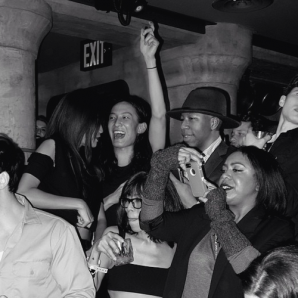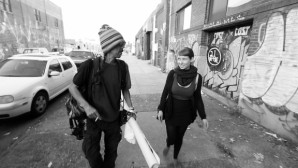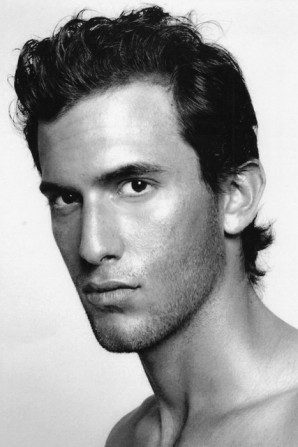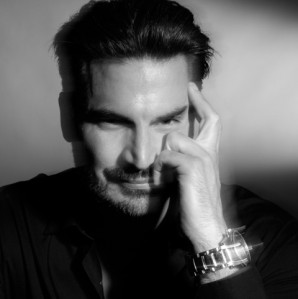TWELV takes a step back and visits the masterminds behind the camera.
NEW TYPE #14: Alida Boer - Alida Boer Interview
TWELV Magazine sat down with Alida Boer in NYC to get to know the designer and better understand the intricacies of her designs and company’s mission.
In a world where Fashion, like other industries, is all too often driven by the bottom line and where profit is sought through cutting the costs of labor and materials at the expense of social values and quality, Alida and her company, Alida Boer, are not just a breath of socially and styistically conscious fresh air, she is a veritable hurricane blowing away notions that profit and high style cannot be achieved while respecting suppliers, workers, consumers, and the environment. Ms. Boer, a former Miss Guatemala, started Maria’s Bags 4 years ago integrating her passion for beautiful handbag design, with a love for the local “huipil” fabric, and a comittment to empowering the women who produce her beautiful designs.
----------- ALIDA BOER INTERVIEW ------------
1. Tell me about yourself, where did you grow up? Growing up, was there something that appealed to you about fashion/design and/or construction that led you to become interested in fashion, specifically bag design?
Well, I was born and grew up in Guatemala City, and when I was 15 I signed a modeling contract. Since that age I moved to Miami and was traveling in London, Greece, and Paris, so I was always very close to the fashion world. And growing up in Guatemala I was always fascinated by the amount of textiles and colors of my country. So, you know, later on, I was miss Guatemala, so I went on to Miss Universe and Miss world, and in one of those pageants I had to do some charity and I helped to renovate a few schools in a town far away. As a thank you gesture they gave me this beautiful textile. I of course loved it, but I didn’t understand the full meaning. I didn’t know how much it took to be done, all the meanings that are behind. It was then when I took it to London that I saw that all the girls from every country were going crazy asking me, you know “where did you get it?” “Where can I find it?” and then I said to myself ‘people love it; people see the art behind it’. So where can we put it in a way we can showcase it to the whole world and every woman can wear it? So, 2 years later I decided that handbags was the perfect way, because women love accessories.
2. Alida Boer differs from the run of the mill fashion company in that as a company it has a commitment to the welfare of its workers. How did you decide on including socioeconomic justice issues in your business model?
You know, I’ve always loved empowering women, I think women are the pillar of society. These artisans are really the artists behind the pieces. It’s not really socioeconomic, it’s honoring the work they have done, because this tradition of textiles and of weaving, has come from hundreds of years ago, it comes from the Mayan culture. So a lot was getting lost because people were not being paid fairly. One textile can take up to 6 months to be done. Imagine in this world where everything is fast fashion to have something like that that has a lot of love, work, and dedication in this piece. Because what you see in these textiles is basically a book of life of that person at that time when the person was doing it. That’s what my artists tell me when they are happy or they’re sad, or when they’re getting married, or having a kid you can really see and feel it in their textiles. So, it’s basically more honoring their work and showing it to the world and paying them what they deserve as the artists they are. Also, another thing that we do is, I have a school where most of the kids of the women go. It goes up to 6th grade and they are learning the Montessori system and also bilingual, because right now in this world it’s very important to have different languages. Especially English to communicate with the whole world. I think as you empower women you start to see a better change in society, because they are the ones that educate the kids, are most of the time with the kids, provide them with food, education, so it’s something I’ve always been committed to. Even now, even more being a mother. Every company should be like this, it should be good not just for the owner, but for society and for the workers.
3. Are you optimistic or pessimistic about the ability of the fashion industry to operate in a manner that treats all of its constituents (workers, suppliers of materials, retailers, designers, and customers) in a fair and equitable manner, while still generating profits?
I focus on how I work, it’s really not my concern how others work. I know that there are certain companies that all they care about is lowering their costs to have a better income, they don’t care about the way they treat their employees or the conditions they’re in. But for us, it’s very important for them to feel they’re in an environment where they can create and really feel free in order to showcase their creativity, to feel important. I think as a human being it’s important to feel that you are a key piece. That’s very important for everything. Sometimes when I see them I show them the picture of people wearing their bags and they feel really excited. So I think when you create that in people they are happy with the job they do. And when you pay them fairly, when you pay them what they deserve, because imagine if they’re taking 2 or 3 months to do this, it is a lot of work. Also your suppliers, for example the leathers we buy, they’re great leathers, you know. We try to have everything that works around have a similar culture of business.
4. What was your first job? Have you always wanted to launch your own collection?
I know this is very cliché, but I started modeling very young. I did it for many years. Since I was young I knew that I wanted to be the owner of my time and everything. So I always wanted to create something that I didn’t have to have a time schedule. You know, I also have a small clinic in Guatemala, so that was my first business where I learned a lot and then now we have Maria’s bag and the factory. So modeling was my first and only job, it was fun, when you’re young and traveling.
5. How would you describe your personal style?
I like elegance, that’s the way I like to dress. Elegant, classic, but at the same time different. I like to not wear what everyone else is wearing. I wear a lot of black, but with bags always a pop of color.
6. Tell me about your creative process. In other words, how do you begin to design a bag or accessory? How do you settle on materials, colors, and textures? Can you describe the creation of a piece from its initial conception through to a final product? Do you look to any sources (museums, other design arts, etc.) for design inspiration?
When we started Maria’s... you go to Guatemala, and the variety of textiles, there’s no other country in the world that has this. I’ve been in many countries, and they have great textiles, but it’s just the amount of it, it’s just unbelievable. In Guatemala, they are different depending on the region and the person, so there’s already a lot of stories behind them. For example, the bag I was wearing with the coat, the beige coat, it’s a love story. It’s a legend, if you see the birds, there’s a princess and it’s about a love story of this princess who’s in love with this guy, but her father was not happy, so he sent this bird as a messenger and he helped them escape and they lived happily ever after. So there’s many things we didn’t want to alter because it’s part of the Mayan culture. So, we let the artisans create and keep their legacies. There’s so many stories and legends, you know, Guatemala has over 24 different languages, it’s such a small country with such diversity. We even have a Noble Prize winner called Miguel Ángel Asturias who wrote Mulata de tal which our last collection was inspired by. We try to always be involved in the Guatemalan culture, because there’s so much to offer in the creative process.
Right now where we really innovate is in the style of the bag. Right now, we’re also working with the different colors of the season, but we really like keeping those traditions alive. We provide them with the threads, after they create the textile, everything goes through a process, even after it’s finished. It goes through a washing process, because it doesn’t matter if the material gets wet, the color won’t bleed. We also provide them with the sizes we want to create and the style of the bag. In the beginning we were just getting textiles from everywhere and creating these beautiful pieces and they’re still one of a kind, because they’re always a little different. We also do limited edition, like, my bag is “huipil” which is the shirt that is used by the Mayan woman, so there’s some that are 60-100 years old. But right now, we provide them with the threads and colors and they’re created in the factory. We own the factory, so we have 25 people that assemble everything. Everything starts from scratch, the way they combine colors is incredible, it’s something that is passed on to each generation, it’s like learning a language. I have a new creative director; we have a great team.
7. How would you describe your customer?
It’s a woman with a very strong sense of style, you know, that really knows what she wants, and wants to be completely different. Like a leader, not someone that follows and wants to be like someone else; someone who is very secure in their style.
8. What do you find to be the most rewarding, challenging, and frustrating aspects of what you do?
Rewarding is to see the impact that you have in women and to bring this beautiful legacy into different parts of the world. We call it Artisanal Couture, because the techniques these women use are the same or even more complex than what’s used in Paris or Italy to do couture. To bring this to different parts of the world, so people can see the talent there is in Guatemala and at the same time have that economic impact for women is the most rewarding thing. It’s been a challenge to work with so many people, we have over 500 women in the network, so imagine to collect all the textiles, to have the times right, to have the quality, so that is quite challenging, but I think we’ve achieved a lot. Frustrating, sometimes, well, I guess in the creative process there are always frustrating things. When you have something in mind and things don’t come out exactly the same and you have to redo the prototype so many times, but it’s part of the process and you can never get it 100% right from the beginning.
9. How do you see the future of design and fashion? Do you think the future of fashion will be based on grassroots movements that require a certain level of respect and integrity to be given to the artisan and environment, especially in an age where we’ve grown accustomed to “fast fashion” that ignores the welfare of the people actually producing the products and the environment?
I think there are so many branches of fashion, fashion as you say, it’s also, we go and we grab our cheap jeans and shirt, but at the same time we want to have a cool bag and shoes, so I think that for me, these pieces transcend what is “in” for the season, this is a piece of art that will be there 20, 50 years from now, where other things we buy are just for that season. So for example, for us, we are an accessory line right now, we want to create pieces that transcend any season or what is just there for the moment. But fashion has so many different things, there’s room for everything, fast fashion, slow fashion, and everyone has such differrent taste and style, there’s so much to be done in this industry.
10. What has been the pinnacle of your career so far?
For me, I think that honestly, every time I’m wearing my bag, they stop me, even men who don’t know anything about fashion, they say ‘I don’t know anything about bags, but I would love to have this for my wife’. They stop me in the airport, even when I put it on top of a cashier, my bag is always a subject of conversation. You know, one time I went to a hotel, 2 years ago in LA at Chateau Marmont, and the guy that was carrying the bags said to me ‘I’ve been carrying bags for 20 years and I’ve never seen such a cool piece’ and this is a man who’s been seeing this, so for me, that compliment was really cool. So I think women in the street carrying my bag, it’s such an amazing thing, really a great feeling that this is getting recognized, because really it’s not just me, it’s all the artists and the team that goes behind this work.
11. What new projects are you working on? What’s next for Alida Boer?
We are relaunching Alida Boer, beginning with the US. The most beautiful textiles; the most luxury and high end bags. We are already in Guatemala of course, we have our flagship there, but we are in Mexico, Dubai, Costa Rica, but the US market is something we’ve always had in mind. And to start to be a brand that people recognize, like any other great brand, because of the craftsmanship behind it. The next collection is completely different bag silhouettes. It’s inspired by Quiche, which is a region of Guatemala, it has three different regions, it’s one of the most amazing places in Guatemala, most of the local people still dress traditionally there. We’re including 9 different styles; it will be really amazing. And we’re including more Guatemalan things, like the pom poms women wear on their heads to make it much more like “it” bags, like iconic pieces.
12. How do you enjoy spending your free time?
I’m finally getting back into a schedule, so I love spending time with my son, going to classes. I think mothers enjoy classes more than the babies, sometimes. I started going to the gym again, which I always love, it’s some space just to bring your day together. I love watching movies and spending time with my family, which is the most important. I love museums, I love art. Especially in New York, you can just go one rainy day to the MOMA or to the Whitney, yeah, I love museums.
ALL BAGS BY ALIDA BOER
INTERVIEWED & WRITTEN BY: ARDEN PICKOFF RAFFERTY
PHOTOGRAPHY: CHIAKI KATO
related posts
IKEMEN #24: LUKE ABBY
IKEMEN (ē´k´mɛn): Japanese Slang
"REALLY, REALLY, RIDICULOUSLY GOOD LOOKING PEOPLE"
ERIN FETHERSTON EXCLUSIVE INTERVIEW
NAME: Erin Fetherston
ORIGIN: California
OCCUPATION: Fashion Designer
CRYSTAL KAY EXCLUSIVE INTERVIEW
NAME: Crystal Kay
ORIGIN: Yokohama, Japan
OCCUPATION: Performer and musician
IKEMEN #23: ANSONI
IKEMEN (ē´k´mɛn): Japanese Slang
"REALLY, REALLY, RIDICULOUSLY GOOD LOOKING PEOPLE"
IKEMEN #22: ADAM SPOONT
IKEMEN (ē´k´mɛn): Japanese Slang
"REALLY, REALLY, RIDICULOUSLY GOOD LOOKING PEOPLE"
BABËL New York Celebrates 1 Year Anniversary With Two Day Event of Excess and Splendor
BABEL NEW YORK acclaimed the NYC party scene in celebration of their First Year Anniversary. As temperatures begin to heat up in NYC, there is no better locale than the much desired rooftop.
BEHIND THE SCENES #2: LUIGI MURENU
TWELV's Behind the Scenes takes a step back and visits the masterminds behind the camera.
IKEMEN #21: MICHELLE VON MANDEL
IKEMEN (ē´k´mɛn): Japanese Slang
"REALLY, REALLY, RIDICULOUSLY GOOD LOOKING PEOPLE"
IKEMEN #20: GEORGE INAKI
IKEMEN (ē´k´mɛn): Japanese Slang
"REALLY, REALLY, RIDICULOUSLY GOOD LOOKING PEOPLE"
DEBORAH ANN WOLL: ALL THE WORLD'S A STAGE
Deborah Ann Woll’s voice glows when she speaks, as warm and full as her golden red hair.
NEVE CAMPBELL: LOSE YOURSELF TO DANCE
Carrying over two decades of the industry on her back, there aren’t many women with the grace and stoicism of Neve Campbell.
GARETH PUGH: ORGANIZED CHAOS
Gareth Pugh is a study in contrasts; balancing the demands of what is created and what is worn; what is in a designer’s control and what is in the hands of the wearer; what must be planned and...
LAKE BELL: THE GREAT LAKE
Lake Bell has made a name for herself as a charming, beautiful, and witty New Yorker capable of indie and blockbuster success (“It’s Complicated”, “No Strings Attached”, “Children’s Hospital...
FRIDAY'S FW PARTY
With Fashion Week’s second day over, Friday night was primetime for some of the most prominent designer to celebrate their successes over a glass of champagne.
IKEMEN #19: SAMAR SAJJAD
IKEMEN (ē´k´mɛn): Japanese Slang
"REALLY, REALLY, RIDICULOUSLY GOOD LOOKING PEOPLE"
Happy Birthday, Kate the Great!
Happy birthday to everyone’s favorite super model Kate Moss. The Brit enters her 40th year with grace, and she looks better than ever.
Lady Gaga's ArtPop Ball
Lady Gaga is back, and this time, it’s not just to perform.
IKEMEN #18: KEIICHIRO NAKAJIMA
IKEMEN (ē´k´mɛn): Japanese Slang
"REALLY, REALLY, RIDICULOUSLY GOOD LOOKING PEOPLE"
IKEMEN #16: KAROLYN PHO
IKEMEN (ē´k´mɛn): Japanese Slang
"REALLY, REALLY, RIDICULOUSLY GOOD LOOKING PEOPLE"
Futura Bold
Futura came up in the grimy, visceral environment of New York City’s early 1970’s street culture of tagging, bombing and writing graffiti – making their art not in the city, but on top of it.
FROM AUSTRALIA WITH LOVE: WHAT I'VE LEARNED SO FAR
Buyer’s Regret: It’s just like buyer’s remorse only in reverse. And it is a fashion crime that I have and will probably continue to commit time and time again.
IKEMEN #15: EDOARDO IANNUZZI
IKEMEN (ē´k´mɛn): Japanese Slang
"REALLY, REALLY, RIDICULOUSLY GOOD LOOKING PEOPLE"
FROM AUSTRALIA WITH LOVE: Designer Profile of Gabriella Ferrante
I find that Australia’s fashion industry can sometime be accused of playing catch-up with other, bigger and more cosmopolitan locations (i.e. Paris, London etc…) This needn’t be the case.
IKEMEN #14: Joao Veiga de Aguiar
IKEMEN (ē´k´mɛn): Japanese Slang
"REALLY, REALLY, RIDICULOUSLY GOOD LOOKING PEOPLE"
FROM AUSTRALIA WITH LOVE: PRETTY BOYS DON'T BUY THEIR OWN DRINKS
Its no secret if you know me – I like to drink.
IKEMEN #13: NATALIE O'BRIEN
IKEMEN (ē´k´mɛn): Japanese Slang
"REALLY, REALLY, RIDICULOUSLY GOOD LOOKING PEOPLE"
IKEMEN #12: KRISTIN PRIM
IKEMEN (ē´k´mɛn): Japanese Slang
"REALLY, REALLY, RIDICULOUSLY GOOD LOOKING PEOPLE"
ARTIST, MODEL, AND LIVING PIECE OF ART: ZOMBIE BOY
From Zombie Boy to living icon, Rick Genest isn’t just Nicola Formichetti’s muse anymore.
IKEMEN #11: JAY PAAVONPERA
IKEMEN (ē´k´mɛn): Japanese Slang
"REALLY, REALLY, RIDICULOUSLY GOOD LOOKING PEOPLE"
DON'T CALL DELANO BROWN A DESIGNER
TWELV met up with the always-unpredictable artist Delano Brown for lunch in Bryant Park.
IKEMEN #10: LOGAN NEITZEL
IKEMEN (ē´k´mɛn): Japanese Slang
"REALLY, REALLY, RIDICULOUSLY GOOD LOOKING PEOPLE"
Rocco Leo Gaglioti
Who are you?
Rocco Leo Gaglioti Creator/Host of Fashion News Live and Owner/CEO of RLG Productions, Corp.
NICOLA FORMICHETTI TUMBLR MEETUP HIGHLIGHTS
“My job feels more like a hobby than a job, really; it’s always fun,” says Nicola Formichetti for TWELV’s second issue.








































